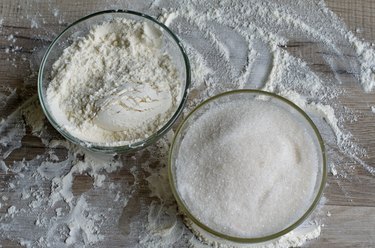
The food trends seem to be changing from one that encourages any type of carbohydrate consumption to one that favors whole grains and eliminates refined white flour and sugar. Refined white flour and refined white sugar cause rapid blood sugar increases and add empty calories to processed foods. Whether you're trying to live a low carb lifestyle or just trying to eat more nutrient dense foods, there are many ways to eliminate sugar and flour from your diet.
Step 1
Eat vegetables in place of pasta. Use a vegetable peeler or sharp knife to cut thin, noodle-like strips of zucchini and boil it for a few minutes until tender. Eat with your favorite pasta sauces. Slice a spaghetti squash in half and cook at 350 degrees until soft, about 45 minutes. Use a fork to separate the pasts-like strands and use in place of pasta in traditional dishes.
Video of the Day
Step 2
Don't drink soda. The average can of soda contains 40 grams of sugar. Diet sodas have artificial sugars that can negatively effect some people. Choose drinks like water and teas with low sugar content.
Step 3
Eat more more fresh fruits, which are unprocessed foods. Canned or packaged fruits are often high in sugar. The same applies to fruit juice. Eat foods that are as close to their natural state as possible.
Step 4
Make your own gravies and sauces, thickened with arrow root, pureed vegetables or cream. Most gravies and sauces have flour and sugar in them.
Step 5
Eat grilled or broiled meats rather than fried. Frying usually involves dredging foods in flour to give them their crispy coating. Broiling and grilling allow you to cook the meat without added flour.
Step 6
Choose wheat free breads. Eat bread made from flax meal, bean, soy or other alternative flours that are not derived from wheat.
Step 7
Avoid cookies, cakes and other deserts, as flour and sugar are usually the main ingredients. Eat fruit when you crave sweets, or experiment with sugar-free and flour-free desserts. Choose nuts in place of candies or pastries.
Tip
Read labels. Check the ingredients in every product you eat to find hidden sugars and flour. These ingredients can exist in places you'd never expect them. Look for words like "high fructose corn syrup" or combination of phrases with "wheat" in them, which usually indicate sugar and flour.
When you eat foods made from refined sugar and wheat, your blood sugar levels increase sharply and then quickly drop, resulting in feelings of hunger that can lead to overeating. Over time, these erratic rises in blood sugar and insulin can lead to more serious issues like increased risk for unhealthy weight gain, diabetes and heart disease. By making a few healthy lifestyle changes -- and committing to stick with them -- you can eliminate refined foods from your diet and help ensure your ongoing good health.
Step 8
Purge your pantry and clean out the refrigerator. Toss out granulated sugar and all foods that contain refined sugar and wheat flour. Get rid of processed foods like cookies, crackers, sugary cereals, white bread, packaged pastries and sugary beverages.
Step 9
Switch to whole-grain food products. Although the refining process creates wheat flour that makes breads and pastries light and airy, it robs the grain of valuable nutrients. The milling process strips away over half of the B vitamins and about 90 percent of the vitamin E. Almost all fiber, which helps keep blood sugar levels stable during digestion, is also eliminated during the milling process.
Step 10
Check for the word "whole" when buying whole-grain foods. Read the ingredients list on food labels when shopping. Whole-grain products list the grain as the first item and will use the word "whole" before the grain. The first ingredient, for example, is listed as whole-wheat flour.
Step 11
Look for hidden sugars when shopping. The "Nutrition Facts" panel on packaged foods includes not only naturally occurring sugar, which is not added sugar, but also lists other added sugars. Since finding hidden sugars can be tricky, look on the ingredients list and food label for items such as corn syrup, honey, high-fructose corn syrup, fruit juice concentrates, fructose, maple syrup, sucrose, brown sugar, dextrose or maltose.
Step 12
Eat more fresh fruit instead of processed and refined treats like candy, cookies and doughnuts. Refined and processed foods are virtually void of health benefits. Fresh fruits, however, satisfy your desire for something sweet while providing your body with fiber and vital nutrients like vitamins A and C, and minerals like iron and potassium.
Step 13
Replace sugary sodas and fruit juices with water. According to Harvard School of Public Health, rising consumption of sugary drinks has been a major contributor to the obesity epidemic in the United States. A 20-ounce soda typically contains 15 to 18 teaspoons of sugar and up to 240 calories. Water, however, contains no sugar or calories and is essential for good health and survival.
Video of the Day